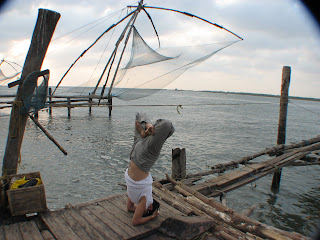OK folks...I have seen a Lot of weird things in my travels, but this one is pretty WILD! A trip to the sacred Pak Ou caves up the river where locals have brought buddhas (4000+) for 100s of years is an awesome sight. Full of prayer and well wishes, these caves guard over the majestic Mekong and the Naga (mystical water snakes) protects the villagers. In fact the villages near these caves believe in the magical power of the Naga so much that thy even make a whiskey that includes the venom of local snakes...this whiskey is used for medicinal benefit and is supposed to have the power to heal many illnesses. This snake medicine is primarily used for men and the illnesses served include arthritis, skin rashes and problems, and will help keep you virile into old age! I am not sure about you, but I will stick to my organic Dr Hauschka creams! Considered for a nanosecond or less to get one, but then thought about it breaking in my luggage.... Of course, they did have a <3oz> Love and laughter from Laos!
ScienceDaily (Nov. 3, 2009) — Thanks to a new method, there is a reason for hope for patients with very severe depression.
Physicians at the University Clinics of Bonn and Cologne have treated ten patients with deep brain stimulation. This involved implanting electrodes in the patients' nucleus accumbens. This centre has a key role in as the brains reward system, whose function may be impaired in depressive people.
Subsequent to this treatment, the patients' depression improved significantly in half of the patients. All patients had suffered from very severe depression for many years and did not respond to any other therapies.
The results of the study will be published in the journal Biological Psychiatry (doi: 10.1016/j.biopsych.2009.09.013).
In deep brain stimulation, doctors specifically target the impaired function of certain areas of the brain with an electric brain pacemaker.
For the purpose of this study, they implanted electrodes in what is known as the nucleus accumbens. That is an important part of the 'reward system' which ensures that we remember good experiences and puts us in a state of pleasant anticipation.
Without a reward system we would not forge any plans for the future as we would not be able to enjoy the fruits of these plans. Inactivity and the inability to experience pleasure are two important signs of depression.
A total of ten patients with very severe depression participated in the study. In all patients, symptoms did not improve despite many therapies using psychotherapy or pharmacotherapy.
Overall, all participants showed signy of improvement, in half of them symptoms of depression improved significantly. Initial effects could sometimes be seen just after a few days.
'Thus, inter alia we observed increasing activity of the patients,' Professor Thomas E. Schlaepfer from the Bonn Clinic of Psychiatry and Psychotherapy explains. 'This was so successful that some of them were even able to work again, after having been incapacitated for many years.
None of our patients had ever responded to any other therapy to a comparable extent before.'
Hardly any side effects
Five patients' well-being improved considerably and in a sustained fashion. Even after a year, the stimulation of the nucleus accumbens still had the same efficacy as at the beginning of the study.
During the study, the scientists also observed distinct anxiety-relieving effects which had not been observed in studies on deep brain stimulation to date.
'Severe anxiety is often an accompanying effect of depression,' the primary author of the study Dr. Bettina Bevernick explains. The overall brain function of the participants was not impaired by the treatment, some neurophysiological functions even improved.
Overall, the scientists only noticed minor side effects, e.g. as a consequence of the operation or after changing the electrical parameters of stimulation. However, these effects always wore off after short periods of time.
Stimulation changes the brain metabolism
But what is the exact effect of the stimulation of the nucleus accumbens? 'We were able to show using functional brain imaging methods that the stimulation changes metabolic rates of different areas of the brain,' Thomas Schlaepfer says.
'What is very important is that the metabolic changes do not just affect the nucleus accumbens itself but also other regions of the limbic system, where the brain processes emotions and that are known to be dysfunctional in depression.
Due to the small number of patients in this and similar studies, the scientists warn against exaggerated hopes.
Moreover, with brain surgery in psychiatric patients specific ethical issues have to be considered very carefully, not least because such an operation is always associated with risk.
'However, our study definitely shows that deep brain stimulation can help some patients with extremely severe forms of depression,' Thomas Schlaepfer stresses. 'That even goes for cases which were thought to be absolutely therapy-resistant up to now.'































